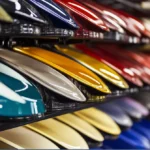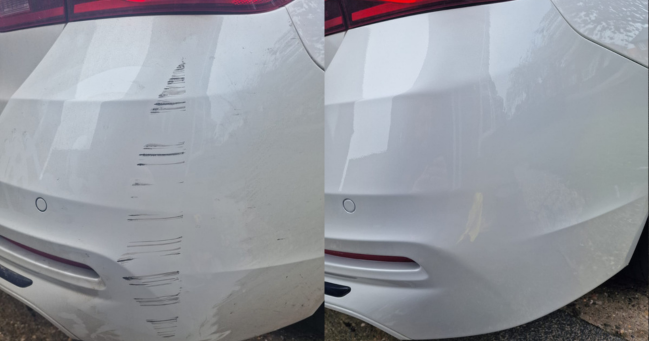
- March 19, 2025
Why Does Car Paint Fade Over Time? A Complete Guide to Protecting Your Vehicle’s Finish
Car paint is designed to be durable and withstand the elements, but over time, it inevitably begins to fade. This gradual deterioration can make a vehicle look older than it actually is, affecting its resale value and aesthetic appeal. Understanding why car paint fades can help vehicle owners take preventive measures to keep their cars looking fresh for longer. In this comprehensive guide, we explore the main reasons behind paint fading, including the impact of UV rays, environmental factors, and maintenance habits.
Understanding the Structure of Modern Automotive Paint
Before diving into why paint fades, it’s important to understand what we’re protecting. Modern automotive paint isn’t just a single layer of colour.
The Multiple Layers of Car Paint Protection
Car paint consists of several distinct layers:
- Primer: The foundation layer that helps paint adhere to the metal and provides corrosion resistance
- Base coat: The actual colour layer that gives your car its distinctive appearance
- Clear coat: A transparent protective layer that provides gloss, depth, and the first line of defence against the elements
When any of these layers become compromised, the degradation process accelerates, leading to noticeable fading and deterioration.
The Science Behind Car Paint Fading: What’s Really Happening?
At a molecular level, several chemical processes occur simultaneously when paint begins to fade.
The Chemical Breakdown of Automotive Paint
Car paint deterioration involves complex chemical reactions, primarily:
- Oxidation: A chemical reaction where oxygen molecules interact with paint compounds, breaking down their structure
- Photodegradation: The process where UV light breaks the chemical bonds in paint polymers
- Hydrolysis: The breakdown of paint components through reaction with water molecules
These processes work together, causing the paint to lose its vibrancy, shine, and protective qualities over time.
UV Radiation: The Primary Culprit Behind Paint Fading
One of the biggest reasons car paint fades is prolonged exposure to ultraviolet (UV) rays from the sun.
How Ultraviolet Light Damages Your Car’s Finish
UV radiation affects your car’s paint in several ways:
- Breaking down the chemical bonds in the paint pigments, causing colour loss
- Degrading the clear coat’s polymer structure, reducing its protective capabilities
- Creating free radicals that accelerate the oxidation process
- Causing microscopic cracks that allow moisture and contaminants to penetrate deeper
Why Certain Car Colours Fade Faster Than Others
Not all car colours are created equal when it comes to UV resistance:
- Red and bright blue cars tend to fade more quickly as their pigments are particularly vulnerable to UV damage
- Black and dark-coloured vehicles show fading more prominently, with discolouration appearing as a chalky, grey surface
- White and silver cars typically show less visible fading, though they still experience clear coat degradation
Why Vehicle Paint Deteriorates Faster in Sunnier Climates
In sunnier regions like Australia, the southern Mediterranean, and parts of the Middle East, cars experience:
- Stronger and more frequent UV radiation exposure year-round
- Higher temperatures that cause expansion and contraction of paint layers
- More intense light that penetrates deeper into the paint structure
- Greater temperature fluctuations between day and night, creating stress on the finish
Oxidation: The Silent Destroyer of Your Car’s Appearance
Oxidation occurs when oxygen molecules interact with the paint’s surface, causing it to break down over time.
Recognising the Signs of Paint Oxidation
Early detection of oxidation can save your car’s appearance. Look for:
- A dull, chalky appearance, particularly on horizontal surfaces
- Loss of reflectivity and glossiness
- A rough texture when running your hand over the paint
- White or discoloured patches, especially on the bonnet and roof
How Temperature Fluctuations Accelerate Oxidation
Temperature changes contribute significantly to paint degradation:
- Heat accelerates oxidation reactions, with every 10°C increase roughly doubling the reaction rate
- Cooling and heating cycles cause the paint to expand and contract
- These dimensional changes create microfractures that expose more surface area to oxidation
Environmental Contaminants That Ruin Your Car’s Paint
Cars are exposed to numerous environmental pollutants that contribute to paint fading, each with unique damaging properties.
Acid Rain and Industrial Fallout
- What is acid rain? Rainfall with a pH lower than normal due to atmospheric pollutants
- How it damages paint: The acidic nature etches into the clear coat, creating minute pits that eventually reach the colour layer
- Industrial fallout particles: Often contain iron or other metal particulates that can bond to and damage paint
Bird Droppings: More Dangerous Than You Think
Bird droppings are particularly harmful because:
- They contain uric acid with pH levels that can etch paint quickly
- They often go unnoticed for hours or days, allowing deep penetration
- The damage they cause can be permanent if not addressed within 24-48 hours
Tree Sap and Organic Contamination
- Tree sap damage mechanism: The sticky substance bonds to the paint surface and, as it hardens, shrinks and pulls on the clear coat
- Curing effect: UV exposure causes sap to cure into a hard, varnish-like substance that’s difficult to remove without damaging paint
- Long-term consequences: Creates uneven surfaces that accelerate deterioration of surrounding areas
Road Salt and Winter Chemicals
In colder UK regions, winter brings additional threats:
- Road salt composition: Contains corrosive chemicals that attack the paint structure
- Splash pattern damage: Particularly affects lower panels, wheel arches, and undercarriage
- Trapped moisture: Salt retains moisture against surfaces, prolonging exposure time
How Your Washing and Maintenance Habits Affect Paint Longevity
While keeping a car clean is essential, improper washing techniques can actually accelerate paint fading.
Common Washing Mistakes That Damage Car Paint
Many car owners unknowingly harm their vehicle’s finish by:
- Using household detergents: These strip protective waxes and sealants while being too alkaline for automotive finishes
- Washing in direct sunlight: Causes cleaning products to dry too quickly, leaving residues and water spots
- Incorrect washing tools: Using sponges that trap grit or rough cloths that create swirl marks
- Circular washing motions: Creates visible circular scratches instead of the preferred straight-line technique
The Importance of Proper Drying Techniques
Drying is just as important as washing:
- Microfibre vs. chamois: The benefits and drawbacks of different drying materials
- Pat-drying vs. wiping: How your drying motion affects paint longevity
- Water filtration: How using filtered water for final rinses prevents mineral deposits
Why Regular Waxing and Sealing Matters
Protective products create a sacrificial layer:
- Carnauba wax benefits: Natural UV protection and water beading
- Synthetic sealants: Longer-lasting protection with enhanced chemical resistance
- Application frequency: Optimal schedules for different product types and climate conditions
Professional Paint Protection Options for Maximum Durability
For those seeking the ultimate in paint protection, professional treatments offer enhanced durability.
Ceramic Coatings: The Modern Solution for Paint Protection
Ceramic coatings represent cutting-edge protection:
- Silica dioxide technology: Forms a semi-permanent bond with clear coat
- Hydrophobic properties: Extreme water repellency prevents contaminant adhesion
- Hardness rating: 9H hardness provides significant scratch and chemical resistance
- Longevity expectations: Realistic timelines for different quality tiers
Paint Protection Film: Invisible Armour for High-Impact Areas
- Urethane composition: Self-healing properties and impact resistance
- Partial vs. full coverage: Strategic application for cost-effective protection
- Maintenance requirements: Special considerations for film-protected vehicles
Professional Paint Correction: Restoring Already Faded Finishes
When prevention wasn’t possible:
- Compound cutting: Removing damaged paint layers to reveal fresh paint
- Multi-stage polishing: Restoring gloss through progressively finer abrasives
- Realistic expectations: Understanding the limitations of correction on severely damaged paint
DIY Paint Protection: Budget-Friendly Ways to Prevent Fading
Not everyone can afford professional treatments, but DIY methods can still be effective.
Creating a Comprehensive Protection Schedule
A year-round protection plan includes:
- Seasonal considerations: Adapting your care routine to winter, summer, spring and autumn challenges
- Product rotation: Using different protectants based on weather patterns
- Inspection routines: Early problem identification before damage becomes severe
DIY Paint Sealant Application Tips
Get professional results at home:
- Surface preparation: Ensuring paint is truly clean before application
- Application techniques: Temperature, humidity and application tool considerations
- Layering strategies: How to combine different products for enhanced protection
Homemade Solutions vs. Commercial Products
- Myths debunked: What works and what doesn’t in home remedies
- Cost-benefit analysis: When to invest in premium products and when budget options suffice
- Ingredient awareness: Understanding product labels for informed decisions
Special Considerations for Different Vehicle Types
Not all vehicles face the same challenges or require identical care.
Classic Car Paint Preservation
Older vehicles often have different paint technology:
- Single-stage vs. modern clear coats: Different vulnerabilities and protection strategies
- Original paint preservation: Balancing authenticity with protection
- Storage considerations: Optimal conditions for vehicles not driven regularly
Daily Driver Protection Strategies
For vehicles facing constant exposure:
- Commuter parking strategies: Making the best of limited options
- Quick protection touch-ups: Maintenance for busy lifestyles
- Realistic expectations: Understanding that some wear is inevitable
4×4 and Off-Road Vehicle Paint Care
Vehicles that venture off-pavement face unique challenges:
- Branch scratch prevention: Products and techniques for woodland driving
- Mud acidity considerations: The unseen threat in off-road adventures
- Undercarriage protection: Often overlooked but equally important
Conclusion: Creating Your Personal Paint Protection Strategy
Car paint fading is an inevitable process, but understanding the causes can help vehicle owners take preventive action. UV exposure, oxidation, environmental contaminants, and improper maintenance all contribute to the loss of vibrancy in car paint. By following best practices such as parking in the shade, applying protective coatings, and maintaining a regular cleaning routine, you can extend the life of your car’s paint and keep it looking its best for years to come.
Remember that the investment in paint protection is ultimately more affordable than repainting, and preserves both the appearance and value of your vehicle. With the knowledge from this guide, you can develop a protection strategy tailored to your specific vehicle, climate, and lifestyle.


